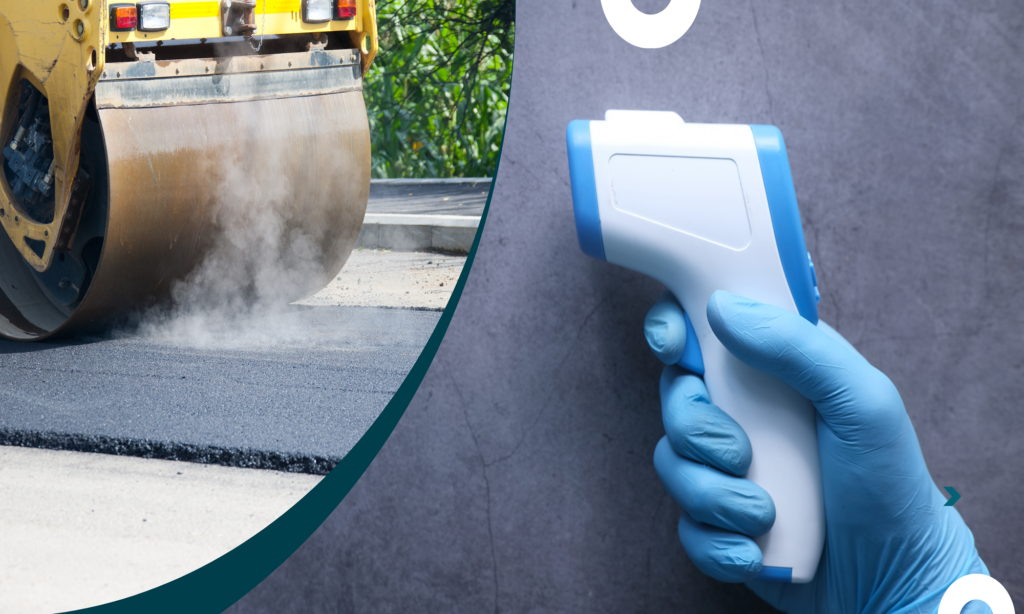Today, we’re diving into the fascinating world of asphalt paving and why temperature monitoring is absolutely crucial in this process. If you’ve ever driven on a smooth, well-maintained road or marveled at a perfectly laid parking lot, you have the art of asphalt paving to thank. Behind its seemingly simple appearance lies a complex science that requires precision and careful attention – particularly when it comes to maintaining optimal temperatures throughout the paving process. Join us as we explore why temperature monitoring is an essential aspect of successful asphalt paving projects. So buckle up and let’s hit the road!
Asphalt Paving
Asphalt paving, also known as blacktop or bitumen paving, is the process of laying down a smooth and durable surface made from a mixture of aggregates, binder, and filler materials. It is widely used in road construction, driveways, parking lots, and other areas that require sturdy and long-lasting surfaces.
The effectiveness of an asphalt paving project depends on maintaining the correct temperature throughout the process. Proper heating of the mixture is required to give sufficient compaction and strong adhesion to the underlying layers. When temperatures are too low, bonding issues, cracking, and unevenness might occur. On the other hand, an excess could cause malfunctions or other damage if it persists for too long.
Maintaining consistent temperatures throughout the entire project is crucial for ensuring uniformity in texture and durability of the pavement. Temperature variations can occur due to factors like weather conditions or delays between mixing batches. Without proper monitoring techniques in place, these fluctuations could go unnoticed until significant issues arise.
By closely monitoring temperatures during asphalt paving projects using advanced technology such as infrared thermometers or thermal imaging cameras, professionals can accurately measure both surface temperature and internal temperatures within different layers of asphalt. This allows them to make necessary adjustments on-site by either heating or cooling the mixtures accordingly.
In addition to controlling quality during installation processes like compaction with precise roller operations based on monitored temperatures ensures optimum density levels are reached resulting in increased longevity of paved surfaces.
Temperature Monitoring
When it comes to asphalt paving, temperature monitoring plays a crucial role in determining the quality and longevity of the pavement. Just like baking a cake requires precise oven temperature, achieving optimal temperatures during the paving process is essential for successful results.
Why is temperature monitoring so important? Well, improper temperatures can lead to various issues such as poor compaction, reduced durability, and increased chances of premature cracking or rutting. By closely monitoring the temperature at different stages of the process, construction crews can make necessary adjustments to ensure that the asphalt mix achieves its desired properties.
There are several methods available for temperature monitoring. One common approach involves using infrared thermometers or thermal imaging cameras to measure surface temperatures during placement and compaction. These tools provide real-time data that allows contractors to monitor potential hot spots or cooling areas that may require additional attention.
Another method involves embedding sensors within the asphalt mixture itself. These sensors can accurately measure internal temperatures throughout the curing process, providing valuable insights into how well the pavement is setting and developing strength.

The Importance of Temperature Monitoring
Temperature monitoring is a crucial aspect of asphalt paving that should never be overlooked. Why? Because the temperature of the asphalt during the construction process directly affects its performance and longevity. Whether it’s too hot or too cold, improper temperatures can lead to a range of issues such as premature cracking, poor compaction, and decreased durability.
One important reason why temperature monitoring is essential is that it ensures that the asphalt mixture reaches its optimal temperature for proper placement and compaction. If the mix is too cold, it may not compact properly, resulting in air voids and weakened pavement. On the other hand, if it’s too hot, there is a risk of deformation under heavy traffic loads.
By closely monitoring the temperature throughout every step of the paving process – from heating and mixing to transportation and placement – contractors can make necessary adjustments to ensure that the asphalt remains within an acceptable temperature range.
Another reason why temperature monitoring matters is that it helps achieve uniformity in pavement quality across different sections of a project. Temperature variations can occur due to factors like weather conditions or an inefficient production process. By continuously measuring temperatures at multiple points along each layer of asphalt application, contractors can identify any deviations from ideal conditions and take corrective measures immediately.
Not only does proper temperature monitoring improve overall pavement quality but also reduces maintenance costs in the long run. When laid at optimal temperatures with good compaction practices, asphalt becomes more resistant to wear-and-tear caused by heavy traffic loads or extreme weather conditions.
Methods of Temperature Monitoring
There are various methods available for monitoring the temperature during asphalt paving. Each method offers its own advantages and can be used depending on the specific needs of the project.
One common method is infrared thermometers, which use a laser to measure surface temperatures. This non-contact technique allows for quick and accurate readings without disrupting the paving process. Another option is thermal cameras, which capture real-time images showing temperature variations across the pavement surface.
For more precise measurements, thermocouples can be embedded in the asphalt mix during production. These small sensors provide continuous temperature data throughout the paving process, allowing for immediate adjustments if needed.
Data loggers are another effective tool for temperature monitoring. These devices record temperature readings at regular intervals, providing valuable data that can be analyzed later to identify any patterns or deviations from optimal temperatures.
There are also wireless sensor systems that offer real-time monitoring capabilities. These systems utilize sensors placed strategically on the pavement to continuously transmit temperature data wirelessly to a central hub or computer software.
By employing these different methods of temperature monitoring, contractors can ensure that they achieve proper compaction and density levels in their asphalt paving projects while minimizing potential issues such as premature cracking or uneven surfaces.

Conclusion
Temperature monitoring is a crucial aspect when it comes to paving asphalt. Maintaining the right temperature throughout the process ensures optimal results and a long-lasting pavement that can withstand the test of time.
By closely monitoring the temperature, contractors can ensure that the asphalt mix is properly heated and compacted. This helps to achieve proper bonding between individual layers, resulting in a more durable and stable pavement surface.
Temperature variations during paving can have detrimental effects on the final product. If asphalt is laid too cold, it may not adhere properly or compact effectively, leading to premature cracking and deterioration. On the other hand, if it’s laid too hot, it may deform under traffic load or result in poor compaction.
There are various methods available for temperature monitoring during asphalt paving. From infrared thermometers to thermal cameras and even specialized software solutions, each method offers its own advantages depending on project requirements and budget constraints.
Regardless of which method is used, regular monitoring at critical points such as delivery trucks, storage silos, paver hopper temperatures, and mat temperatures during placement should be conducted to ensure consistency throughout the entire process.
Temperature monitoring plays a vital role in ensuring high-quality asphalt pavement construction. It allows for better control over material properties and helps prevent common issues associated with improper heating or cooling of asphalt mixes.
Next time you see freshly paved roads or parking lots that stand strong against wear and tear year after year – remember that behind their success lies careful attention paid to temperature monitoring during installation!
So whether you’re planning a small residential driveway or a large-scale highway project,
Remember: keeping an eye on those temperatures will pave your way toward excellence!

